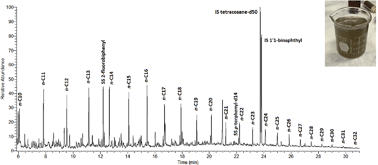Solid-phase extraction followed by gas chromatography-mass spectrometry for the quantitative analysis of semi-volatile hydrocarbons in hydraulic fracturing wastewaters
Abstract
A versatile method was developed for the quantitative analysis of semi-volatile linear aliphatic hydrocarbons in the n-C10 to n-C32 range and 16 polycyclic aromatic hydrocarbons (PAH) in hydraulic fracturing wastewaters using solid-phase extraction (SPE) on disposable octadecyl-bonded silica (C18) cartridges followed by gas chromatography-mass spectrometry. Matrix spikes revealed SPE recovery rates in the range of 38–120% for linear aliphatic hydrocarbons (n-C10 to n-C32) and 84–116% for PAH. Limits of detection were in the lower ng L−1 range for both compound groups. To prove the practicability of the developed method in real applications, the treatment performance of a hybrid forward osmosis–reverse osmosis pilot system treating produced water from the Denver-Julesburg basin in Colorado was assessed over a period of eight weeks. The removal efficiency of the overall system after reverse osmosis treatment for n-alkanes was constantly better than 99.4%. The lower molecular weight PAH naphthalene, fluorene, and phenanthrene were the most abundant PAH detected in the produced water feed, filtrate and concentrate streams during treatment. Their concentrations in the produced water feed reached up to 359.3 μg L−1, 40.7 μg L−1, and 68.3 μg L−1, respectively. However, naphthalene (0.5 ± 0.2 μg L−1) was the only analyzed PAH in the final treated water that exceeded the general US Environmental Protection Agency maximum contaminant level for PAH in drinking water of 0.2 μg L−1.


 Please wait while we load your content...
Please wait while we load your content...